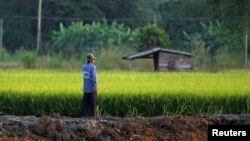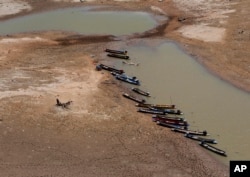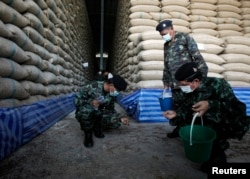Thailand’s rice farmers are struggling with drought, low returns, and rising competition as a new era of trade opens under the ASEAN Economic Community (AEC). But growers hope to weather the hard times by drawing on years of farming experience and hopes of a revival in rice prices.
In Amnat Charoen, a provincial town in northeast Thailand, villagers at a local fairground compete in teams to mill rice. The winners are judged by the highest quality product.
Farmers struggle with low prices
The farmers celebrate as rice fields lie fallow over the dry season and await monsoon rains later in the year to plant a new crop.
Amnat Charoen, a town near the border with Laos some 600 kilometers from Bangkok, is famed for its rice, notably Hom Mali or fragrant rice, well known on international markets.
But Thailand's farmers are facing difficult times, with a severe drought, rice prices at six year lows, stagnating incomes and rising debt.
In the village of Ban Plah Khaow, 20 kilometers from Amnat Charoen Town, retired engineer Ajarn Ting said the outlook is bleak.
Ting said the situation is ‘no good.’ Rice prices are down with the popular jasmine rice low with prices of other rice varieties also low, making life difficult for farmers.
Farmers call for assistance
The current downturn has triggered calls by farmers for government assistance, said Athikarn Ringcharoen, Chamber of Commerce President for Amnat Charoen province.
Athikarn said the price of rice was weak and farmers are having to sell to millers quickly because they need funds for their families. They are accepting the gate price (standard price), to sell as fast as possible.
Thailand’s central bank has warned that an ongoing drought and lower agricultural prices are already adding pressure on rice farmers’ incomes.
The Thai Rice Exporters Association said the price for Hom Mali fragrant rice is at its lowest in six years at just $720 per ton, from a peak of $1,200 per ton.
Thailand’s rice industry is still recovering from the end of a rice price pledging scheme set up under the former government of prime minister Yingluck Shinawatra, who was ousted in the May 2014 coup.
Supporters of the plan say it boosted farmers’ incomes. But critics say the program was riddled with corruption, decimated Thai rice exports, cost Thai taxpayers more than $14 billion and left thousands of farmers in debt.
Songphan Jansawang, chief of the agricultural department in al Amnat Charoen, said farmers from the northeast Isaarn region have had to adapt to survive the dry conditions.
Songphan said the people of Isaarn have had to live with the drought from generation to generation and adjust. Jasmine rice grown in the region is also known as a hardy variety of crop suitable to dry climatic conditions.
He said farmers also face growing competition from regional rivals in the rice market as liberalization comes into effect under the ASEAN Economic Community (AEC) launched late last year.
Thailand’s Commerce Ministry said it also plans to restructure the rice sector, lowering the total crop from 33 million tons to 25 million tons to avert an oversupply and diversifying rice varieties away from traditional white rice.








